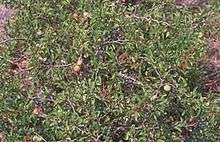Prunus geniculata
| Prunus geniculata | |
|---|---|
 | |
| Scientific classification | |
| Kingdom: | Plantae |
| (unranked): | Angiosperms |
| (unranked): | Eudicots |
| (unranked): | Rosids |
| Order: | Rosales |
| Family: | Rosaceae |
| Genus: | Prunus |
| Species: | P. geniculata |
| Binomial name | |
| Prunus geniculata R.M.Harper [1][2] | |
Prunus geniculata is a rare species of plum known by the common name scrub plum. It is endemic to Florida in the United States, where it occurs on the Lake Wales Ridge in the central ridges of the peninsula. It is threatened by the loss of its habitat and is a federally listed endangered species of the United States.
This plant is a low, rounded shrub with a gnarled trunk emerging from the sand and branching densely to form a mound up to two meters tall. The zig-zagging, angled, sharp-tipped branches are sometimes buried in sand and emerge covered in lichens. The gray bark cracks, revealing new reddish brown bark beneath. The alternately arranged leaves have smooth blades 1 to 3 centimeters long with wavy or toothed edges. Blooming occurs before the leaves appear. The flowers are usually solitary. They have five red sepals and five white petals a few millimeters long. There are many stamens at the center, each with a yellow anther. The species is andromonoecious, with individuals bearing both bisexual and male-only flowers.[3][4] The fruit is a bitter-tasting, egg-shaped drupe up to 2.5 centimeters long.[5] The drupe is reddish purple in color and is consumed by animals.[3]
This plant grows in yellow-sand sandhill habitat dominated by longleaf pine and turkey oak and white-sand Florida scrub among sand pine, Florida rosemary, and scrub hickory.[5] The plant may be solitary or it may grow colonially. Little is known about the plant's life history.[5][3]
The plant's native habitat is maintained by periodic wildfire. The natural fire regime in the area produces openings in the vegetation, removing woody, overgrown plants in the canopy and creating gaps where the smaller plants can receive sun. This shrub cannot tolerate shade and it thrives when fire clears the vegetation around it.[5] It resprouts from its fibrous root system after its aboveground part burns.[3] Flowering increases in the seasons after a fire, then decreases the longer the area goes unburned.[4] The plant is long-lived, has low mortality, and can survive many years without fire. However, fire suppression is the major threat to the survival of the species.[6]
Another threat to the species is the outright loss of its habitat in the conversion to residential and agricultural properties, including citrus groves.[5] The plant's own biology may contribute to its rarity: germination rates are low and many of the developing fruits are lost before they mature, either to abortion or predation.[4] The species then experiences low recruitment, with few seedlings joining the population.[6]
As of 2008 there were 83 populations counted, but 39 of these contained fewer than 10 plants each. Most populations are on the Lake Wales Ridge, and a few are on adjacent ridges. Half the populations are on private land, but most of the large populations are in protected or managed areas.[6]
References
- ↑ Prunus geniculata was first described and published in Torreya. 11: 67. 1911 (Note: the article in which the name appears begins on page 64, the species name not appearing until page 67.) "Plant Name Details for Prunus geniculata". IPNI. Retrieved July 9, 2011.
- ↑ Roland M. Harper (1911). "A New Plum from the Lake Region of Florida" (PDF). Torreya; a Monthly Journal of Botanical Notes and News. New York: Torrey Botanical Club, USA. 11: 64–67. Retrieved July 9, 2011.
- 1 2 3 4 Prunus geniculata. Center for Plant Conservation.
- 1 2 3 Weekley, C. W., et al. (2010). Multiple causes of seedling rarity in scrub plum, Prunus geniculata (Rosaceae), an endangered shrub of the Florida scrub. Am J Bot 97(1) 144.
- 1 2 3 4 5 Prunus geniculata. The Nature Conservancy.
- 1 2 3 USFWS. Prunus geniculata Five-year Review. May 2009.
